Food Art: The Art That Will Make You Drool

In the 21st century, it is becoming harder to come up with original ideas and to create unusual or unique art works. So many things have already been done. Art has expanded to everything and anything, from Marcel Duchamp’s ready-mades to Tadashi Kawamata’s piles of chairs. Nowadays, everything is used: matches, garbage, furniture, digital technology, umbrellas… and even food. The figurative makes way to the conceptual. Art is found out of galleries, in the street, in the landscape or on screen… and even in your plate. Yes, a new form of art emerges and gains more and more legitimacy – food art. To understand its development, it is essential to look at the past relationship between art and food, represented in a number of paintings and drawings. Little by little, food came out of the canvas and became a material just like paint, or pencil, or paper. This article aims to explore the different forms of food art and the talented artists connected to it, so get ready to be amazed… and bon appétit!
Food in Art History
Food has always been at the centre of our lives; we need it for our survival of course, but it also plays a significant part in our social and cultural lifestyles. We gather a whole community around food, share it with the people we love – good memories are often associated to what we eat on that particular moment of joy. For example, Proust evokes a madeleine (little tea cake) as a catalyst to the ecstatic revival of his childhood memories. And we all remember Tolkien’s wonderful descriptions of grandiose feasts where wine is poured abundantly and plates are never empty (I suggest reading this article). So it is logical that painters, like writers, expressed a vivid interest in food and its visual representation. They painted sumptuous scenes of banquets but all in very different styles and tones, where food mirrored the frames of mind of the people celebrating.
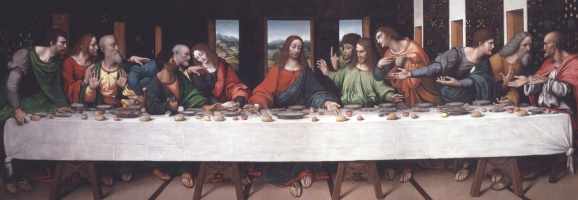
Some Middle Ages and Renaissance canvas represent the feast as an extravagant display of pleasures, a bacchanal orgy where food leads to debauchery. In contrast, the food in Leonardo da Vinci’s The Last Supper (1494-8) appeals to sobriety and abstinence – the characters do not touch their food, little unattractive loaves of bread disposed symmetrically on the table, absorbed by their private discussions. Later, artists started to paint humble people like peasants and farmers eating their simple meals, like Van Gogh’s The Potato Eaters (1885). On the other hand, the Impressionists depicted harmonious scenes of collective dinners, all in subtlety, refinement and delight, like Manet’s The Luncheon on the Grass (1863) or Renoir’s Luncheon of the Boating Party (1881). The colours, the light, the smiling faces and the palpable eroticism transmit that feeling of enjoyable indolence, and food is presented as a central element of the scenes, either placed in the middle or in the first plane. Thus food’s representation became as important as the characters depicted, and painters focused on conveying moments of real life.
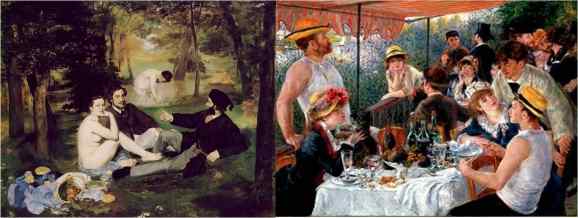
But some artists chose to exclude the characters from their works and privileged what we call ‘still lives’, where inanimate objects became the subject matters of the painting. Food was the primary source of inspiration, and several paintings depict tables full of dishes, bowls of fruits, bottles of wine and sometimes, dead animals like fishes or ducks. Through still lives, painters try to freeze a point in time, an instant of life – the leftovers of a banquet, tea time’s preparations, the cutting of meat – all in the most realistic perspective. In the 20th century, still lives followed the cubist and abstract expressionism trends and became less figurative. With the arrival of the consumerist society and the rise of new movements like pop art, neo-dada and photorealism, our visual perception of food radically changed.

In the first part of the 20th century, Neo-dada broke the artistic conventions of realism and completely redefined perspective. Neo-dada artists deformed lines, juxtaposed the planes, removed the depth of field and reinvented colours. Still lives became drastically abstract and food lost its shape and flavour – painters did not want to appeal to our taste, they wanted us to think about the changing nature of society in a time of political turmoil, where even the pleasurable things in life were tainted with bitterness. Food became an excellent subject matter to criticise society. With the economic development and the arrival of consumerism in the mid-twentieth century, artists started to represent popular products like tin cans or Coca-Cola bottles in their works, and associated the basics of advertisement to their art, often incorporating famous brands in their canvas. Andy Warhol criticized the rise of a homogenous society through his 32 Campbell’s Soup Cans (1962) placed next to each other in a linear, monotonous continuity. Lichtenstein’s Still Life with Crystal Bowl (1973) appears surreal, as if the fruits in the bowl were cut off a magazine or a comic book, completely fake and unsubstantial. Photorealism made fun of the advertising technique; by choosing an intense lighting and augmenting the colour contrast, the food looks like plastic, completely unnatural. Hence our visual representation of food transformed itself according to advertising’s dictates and became more abstract, fabricated and counterfeit.
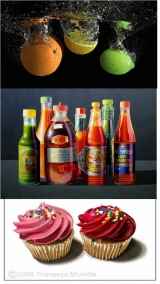
In the 1960s, a new movement called Eat art started to use food as a material in artistic creations. The movement radically changed the essence of artwork – it was no longer limited by materialistic boundaries and could use food, permeable products, to form an ephemeral art. It was led by Daniel Spoerri famous for his tableaux-pièges (literally canvas-traps); after enjoying a meal with his family or friends, everything was left on the table and fixed with a special spray so that it could stick to the napkin and be exposed on the wall. Through his special canvas, Spoerri suspends time, highlights the social connotation of sharing food and makes the day-to-day banality of a meal access the highest realms of art. Spoerri opened the way to a new form of art, proudly taken over by the food art movement which entirely changes the public’s conception of an artistic work and makes him consider what he eats in a totally new manner.
Food art, an incredibly diverse movement

Today, food art is very diverse: artists mix with chefs, bloggers and hobbyists to create original and unique artworks. In their works, food artists incorporate aliments in very different ways – some use it as a support to draw, others sculpt with it, but the purpose is always to impress and challenge the viewer’s assumptions about what art should look like and how food should be used. Some artists use food like paint; for instance, Vivi Mac practices ‘speed-painting’ and draws unbelievably realistic faces with gum, maple syrup or cocoa powder.
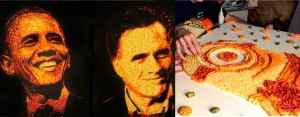
In Florida, artist Cristiam Ramos sketches celebrities’ portraits with candies that he aligns one by one to create a picture. Jason Baalman uses the same concept but with crackers. For the American presidential campaign in 2012, he created two portraits of 4 feet high, one of Barack Obama and the other of Mitt Romney, with more than 2000 Cheetos for each picture.
Others choose food as a support for painting, instead of canvas. For example, artists like Brittany Powell, Tae Kitakata and Ida Skivenes reproduce famous works like Munch’s The Scream (1893) or Dali’s The Persistence of Memory (1931) with cheese, vegetables and sauces on slices of bread. This will change your way of looking at your morning toasts!
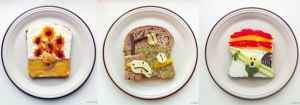
Who has never tried to make necklaces out of pasta, towers with slices of mandarins or trees out of broccoli? Food unleashes our imaginative power with its colours and shapes. It is a privileged tool for sculpture and several artists exploited that potential to create breath-taking objects out of vegetables and fruits. Dan Cretu, Romanian photograph, transforms objects of our daily lives like bikes or cameras into sympathetic eatable sculptures. Others like Ray Villafane and Andy Bergholtz carve incredible faces into pumpkins for Halloween. Pure art!

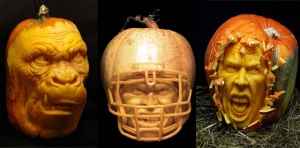
Carl Warner, British photograph, is also a ‘foodscape’ architect. He creates fantastic landscapes with vegetables, candies, fish, meat and fruits and gives birth to an enchanting world, Alice in wonderland style, full of magic, fantasy and poetry.
‘I tend to draw a very conventional landscape using classic compositional techniques as I need to fool the viewer into thinking it is a real scene at first glance. It is the realisation that the scene is in fact made of food that brings a smile to the viewer, and for me that’s the best part.’

As we saw with Warner, food art touched the world of photography as well. Some photographs became food designers and used technology and computer changes to add a more conceptual layer to the food art movement. Beth Galton, for instance, spends her time photographing food in the most unusual ways, her latest work being a series of dishes cut in half where the viewer sees the inside of a cup of coffee or a jar full of spaghetti. Sakir Gökçebag, a Turkish photograph, rearranges food in graphic ways to create asymmetrical or oriental patterns, like mosaics and without using Photoshop.

Finally, food art has also infiltrated the podiums and is becoming the new fashion trend. Fashion designers use vegetables and fruits instead of fabrics to invent original and elegant outfits, worthy of fairies and nymphs. Yeonju Sung realised a series of clothes called ‘Wearable Food’, composed of delicate and subtle pieces made of vegetables, all environmentally friendly. And this is not only found in alternative fashion – Fulvio Bonavia, Italian designer and photograph, takes inspiration in the most famous outfits in Haute Couture to create his own eatable dresses. His book ‘A Matter of Taster’ presents reproductions of luxury bags made of raspberries or broccoli. He has imagined an Alexander McQueen dress all in romaine lettuce or a Prada outfit in citrus fruits. So think twice before throwing your vegetables away…
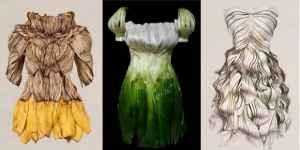
Food has now become more than a need – it is an art, literally. Cooks and bakers create exceptional food sculptures and develop an art out of it, but it is still considered food and is meant to be consumed. With food-art, artists have incorporated food at the core of their work and transformed it into a tool and a material in its own. They have revolutionized the way we conceive art and the way we regard food. Challenging our modes of representation and our understanding of reality, they have proved that art can regenerate itself on the basis of anything and doesn’t limit itself to the tradition, just as food doesn’t limit itself to its primary purpose. As long as you have imagination, you can make everything out of anything.
What do you think? Leave a comment.











This article is so great ; )
I especially like the toast paintings. That could be a lot of fun for artists…in a traditional printmaking course I took years ago, I used bread to print from on the press and half the bread stuck to the paper. It’s still hanging on my wall, slowly rotting away hahaha…!
Thanks, I’m glad you liked it! Hahaha, I guess it’s a good souvenir 🙂 Yes it looks really fun, I want to try as well but I don’t think I will hang my attempts on the wall!
Mum always told me not to play with my food.
I could have been great.
Awwwww! Never too late to start 🙂
This was really interesting and cool…thanks for writing it.
You’re welcome, thanks for reading it and glad you enjoyed it!
Wow, an exhaustive look at food as a source of inspiration for artistic expression over hundreds of years and a multitude of artistic styles. I like the Mona Lisa in BBQ sauce best.
Thank you. Yes some of her things are so impressive!
Seeing the long history of food in art is food art itself really a “new form” or is it more an evolution of the subject alongside the unfolding of art through its history? I struggle a little with this myself. I can see how food in art and, the more modern, food as art are separate things but there are arguments to be made for either side. Let me know what you think. Thanks for a great article, I really enjoyed it!
Hey Christina, thanks for reading the article, and very interesting question! I don’t really know, it is a tough one, I guess it’s up to everyone’s interpretation really…but for me it looks like it is kind of both. Food art seems to me as a natural evolution. Artists tried to reinvent the notion of art and change food’s visual representation, and in order to be more creative and original, used food as a material. Yet this has created a new form of art, something innovative that no one had considered before. I really believe it is a new form of art, especially in our time, because it has evolved so much and has reached enormous proportions. Even in the way it is presented, the fact that anyone (with skill :)) can do it and post their art online – this is also a new form of approaching art. Hope I make sense
Food art is fun and lovely to look at.. it can add to the food presentation.
The paintings of gum and toothpaste reminded me of the murals I saw at the Jelly Belly factory in elementary school. Talented people!
Now I must share it among my food lovers. Thanks!
Great Creativity!!!
Now I’m hungry…but I don’t want to eat the pretty food!
Nice summary of a varied field. In the past decade or so, with performance artists like Marina Abramovic collaborating with well-known chefs on “food interventions,” I wonder how the cult of celebrity that has intensified around cooking–along with the slow food, locavore and other movements–has influenced the art world. In other words, in recent years, I think there are a number of food trends emerging independent of the art world that artists are tapping into that now treat food (its growing, preparation, eating, etc.) as a performance vs. a medium. Of course that will solve some of the many problems that museum curators have had with trying to preserve food-based art forms where the emphasis is on food as the end product vs. performance.
One of my personal favorite food/art unions is the photo series “No Seconds,” which features last meals of deathrow inmates. http://www.dripbook.com/hhargreaves/portfolio/no-seconds/
A related project, Julie Green’s “Last Supper,” consists of a series of last meals painted on simple glazed ceramic plates. http://www.npr.org/blogs/thesalt/2012/06/06/154447333/artist-protests-death-penalty-by-painting-prisoners-final-meals
Interesting links! Really insightful, thanks for sharing
This is a great overview of the history of food art. I have studied the intersection of food and art quite extensively. If you are interested, follow the link to my blog from my profile. You will find some essays that I have written on the subject. Also, I recommend the work of Carolyn Korsmeyer, especially her book “Making Sense of Taste: Food and Philosophy.”
Again, great work!
I think it’s worth complimenting the fact that not only can food be prepared to eat an artistic craftsmanship, but making sculptures, visuals, or clothes out of food is possible and incredibly creative. I do appreciate the talent and artistry, but I also am concerned at how much consumption each project took. Rather than creating ephemeral art, would it not be more worthwhile to donate to the hungry? Giving can be just as gratifying as creating.
Food is a beauty that is fleeting, something that is to be appreciated in moments of time — much like life itself.
Your summary of the history of food in art was interesting and I’ll have to keep my eyes out for food representation in the future. As far as contemporary works, you assert that they are challenging our conception of what constitutes fine art, and that’s well and good. But as you yourself say, everybody is using everything nowadays to create art, so an artist can still challenge that conception, but there must be something else as well, and it is that something that I think is really important. In other words, these artists are (hopefully) making art with food because that medium speaks directly to the message or impression they wish to send. Now, of course, for each artist that message might be different, but with a medium like food, I could imagine there being some trends. Something to look for!
Tasty.
Art images of food made with food…. how harmonious!
I think that food in art/ art created with food is less of a new development and more an idea that is only recently flourishing. Regardless, it’s interesting and beautiful.
Great article! Those pumpkin carvings are insane, it’s hard to imagine how someone could take the time to create an inevitably disposable – yet awesome – piece of art.
This is amazing. I had no idea this was a thing! Besides pumpkin carvings, I’ve never seen a lot of art with food. It is just sad that most art made from food cannot last forever. It is like a wedding cake, almost too pretty to eat, but you’ve just got to see if it is as good as it looks!
It’s pretty awesome!!
Food can be turned into a fine form of art!
Food can be attractive!!art really is formless,yet,so fascinating!!
To the author,you did an account excellent job!
an encompessment of the commodification of art and its changing body symbolised through the meanings of food. the functioning of food is equated with the functioning of life hence the timeline and art history presented here through food is a functioning of canonical history making via art. Enough said.
Now i’m hungry……
The pumpkins look like an advanced development of the jack-o-lantern.